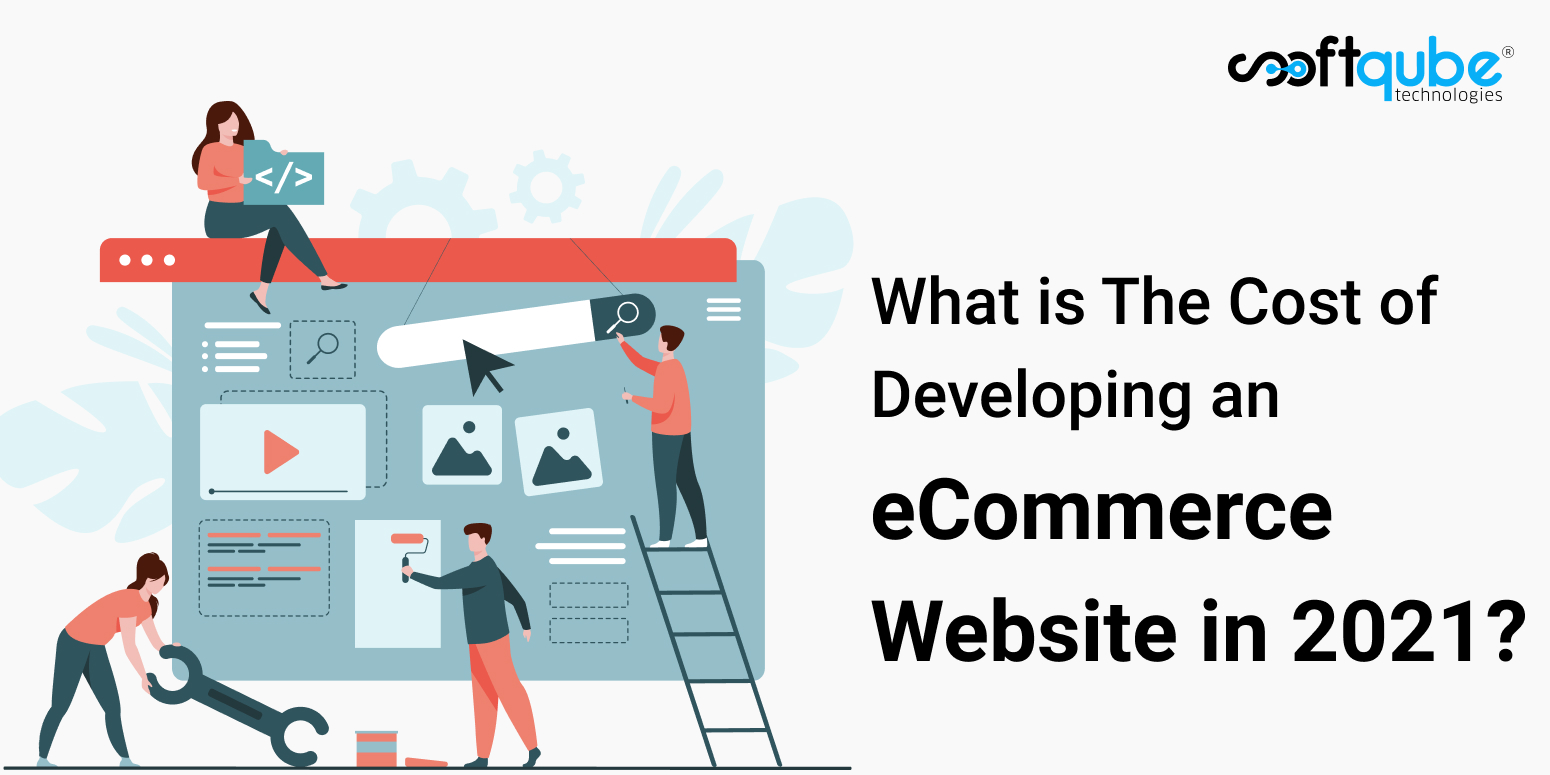What is The Cost of Developing an eCommerce Website in 2021? – A Comprehensive Guide
November 23, 2021

Table of Contents
- How To Scale Your eCommerce Website With Suitable Method
- Cost Allocation of Your eCommerce website
- Website Cosmetic Creation Expenditure
- Cost Based on Functionality
- Cost of Typing in Physical or Digital Ends of the Store
- Cost of Marketing With Various Methods
- Maintenance Costs
- Miscellaneous Costs and Spendings
- How Will Softqube Help You Build a Robust eCommerce Website?
You will have to consider several attributes while estimating the cost of an eCommerce website. From the website design to including the advanced features, you need to decide upon the maximum budget, your specific need, and the chronological breakdown of the website elements. Once you determine the goal and identify every single aspect of creating a robust eCommerce website, you are all set to acquire the accurate cost of building it.
Based on our experiences and the prevailing market scenarios, an eCommerce website costs somewhere around $5000 to $200000. Sometimes it can be even more. Well, to make your job easier and quite simpler, you can ask yourself these questions. Once you get the answers, you can take it ahead and frame other aspects with great convenience.
- What is the scale of your website?
- What kind of traffic do you expect?
- How soon do you want it to be ready?
- Do you want to develop a custom website or wish to use a SaaS platform such as Shopify instead?
- How much emphasis will be put on the design?
- What additional features do you want on the website?
- How many products will be listed on the website?
- What kind of marketing strategy do you want to follow?
The answer to these questions will bring you closer to the right figure. Well, this is just the beginning. The way forward, you are supposed to answer plenty and for that keep reading the below article to get more insights and a deeper clarity of what you really want for your eCommerce website.
We shall cover the below topics.
How To Scale Your eCommerce Website With Suitable Method
The buzzing internet is an abode to all kinds of eCommerce websites. From online stores hovering around with a singular product to finding a holistic platform that sells every single thing under the sun. However,every website has a different goal perspective that varies with scope and objectives. And so they employ different methods of building their website.
So first things first, identify your position in the eCommerce market. Who are you? A startup with a huge capital or a successful retailer with an established business. Because the key to tracking an ideal website in your mind is strongly based upon your financial independence.
Secondly, it also comes down to a particular method in which you want to build your website. Like do you want to keep it open-sourced or a SaaS eCommerce platform or a customized one? Every method has its pros and cons. To understand each of them thoroughly and keep reading below to know more.
Cost Allocation of Your eCommerce website

This table will help you understand how the cost varies from one case to another. It’s the functionality section where you could cut cost the most by going with SaaS eCommerce platforms such as Spotify. These platforms will save you a lot of time and money, but they aren’t the ideal option if you want your eCommerce store to stand out. However, you can counter this demerit through customization, and also scale as per requirements.
On the other hand, there are no boundaries in terms of features, cost, and time. Even though you can customize various aspects of your SaaS-based store, custom development will always be more flexible and effective.
Website Cosmetic Creation Expenditure
Users come with the shortest possible attention span. Looking into the abundant options available for every single thing, you must find out a way to grab the attention of these individuals and stay there for a longer time to make purchases. Get impressive user interfaces. The design plays a crucial factor to make your website stand out from the rest of the competitor market.
Taking the advantage of the eCommerce platforms like Shopify and WooCommerce, one can build magnificent web design without spending a single penny. These platforms come with free themes that come in handy for those walking on a budgetary tightrope. Some of these free themes look amazing too; however, the cookie-cutter options eventually prove insufficient achieving only the bare minimum.
Another option is to get one of the paid themes. A Shopify theme would cost you somewhere between $140 to $180. Such themes are more professional and rare compared to the free ones. Moreover, you can take them a couple of notches higher by customizing them. You can expect to shell out $1,000 for minor changes and branding the theme. And if you are looking to introduce a wider variety of changes, then the customization will cost north of $5,000.
If you want a customized development model, then there is no limit to the design cost. It all depends on how engaging UX you want to keep. If you’re a retailer planning to take your brick-and-mortar store online, then brand perception matters even more. Custom designing costs begin from $10,000 and go up to thousands of dollars. The price for design also varies with features. Numbers such as $30,000 and $75,000 aren’t exactly ludicrous for an eCommerce-website design.
Cost Based on Functionality
You need some very basic features no matter how simple or advanced a store you wish to create. So get the basic functionality with the right features to ensure you meet up with the needs like product management, shopping cart, a payment module, etc.
If you’re going for a simple eCommerce website, then you’ll discover that most features are already there. Irrespective of the eCommerce platform you use, there will always be plenty of gaps in terms of functionality.

The plug-ins and add-ons come quite handy. You can easily find out the free and paid add-ons to improvise the functionalities of the site. The things get trickier here. The free ones are not so good. Usually, the third parties develop paid ones and so they do not always go well with the website.
So, go for the customization. That will always be great.
Basic features: SaaS platforms
Just the way it was with themes, you can also hire developers to customize the add-on for your site. They could even create one from scratch. The two options depend on what you need. The customization for basic eCommerce features on platforms like Shopify and WooCommerce can cost between $5,000 and $15,000.
Advanced features: SaaS platforms
Customizing advanced features requires a bigger budget. If you have a decent eCommerce website budget, you should go with customization. The more functional the website, the easier it becomes to attract customers. For this bump, you’d need to pay an extra $5,000 to $12,000.
Having said that, there aren’t very many changes when you move from eCommerce platforms to custom eCommerce development, and the importance of basic and advanced features remains the same.
Basic features: custom development
The average cost of primary-eCommerce features for custom development ranges between $20,000 and $30,000. They include features like product management, product categorization, payment portal, and the like.
Advanced features: custom development
However, if you wish to augment your basic custom eCommerce website with advanced features, this upgrade will cost around $10,000 to $16,000. Discount management, personalized suggestions, wishlist management, and multiple languages are some of these advanced features.
Cost of Typing in Physical or Digital Ends of the Store
Website building is just a part of the entire game of running a successful eCommerce business. It is just half the battle won. So keep up with your promises by delivering the services on time, maintaining product quality, and serving the customers with a difference.
Here, the fulfillment service shall remain the backbone of your eCommerce business. It doesn’t have much to do with the website, but you need to ensure that your fulfillment software is in sync with it.
It should automatically update inventory status, send out notifications, seamlessly interact with delivery partners, and generate accurate invoices. And this list has just the bare minimum actions.
You can either get an eCommerce-fulfillment software or get one custom developed. Most fulfillments come with a monthly subscription plan. It works well for most eCommerce startups as they can always scale later, thus saving a handsome amount during the initial stages.
Options are available in quite the range. You can get one for as low as $30 per month and as high as $400 per month. There are also a few which charge a one-time license fee. These alternatives could charge you around $5,000. And if you decide to get it custom developed, this cost will also be in the vicinity of $5,000.
Cost of Marketing With Various Methods
You have a fantastic website with great features and wonderful products. But the problem is the customers are not particularly visiting your site. If this is the case, how would you solve it?
You have to attract shoppers to your eCommerce website, especially at the beginning to gain some traction. A lot falls under the marketing umbrella — everything from the web copy to a PPC campaign is capable of generating traffic.
Start with SEO and Copywriting. The cost of copywriting is directly proportional to the number of pages and is more like a one-time investment. SEO, on the other hand, is a dynamic process: you need to keep at it for as long as the store is functional.
SEO and copywriting will depend a lot on the type of your website and its scalability. If you’re a small eCommerce startup with a limited budget, you can take care of them yourself. Just put in some effort, and you’re golden and you do not need to spend much for this.
For medium and large businesses, marketing plays a more prominent role. They go beyond SEO and invest in PPC campaigns, remarketing themselves, and other digital-marketing strategies. Some create blogs while others resort to email marketing. There are just so many ways to get the job done.
The cost of marketing can amount up to $500 to $2,000 for a small store whereas it can shoot up in the range of $4,000 to $5,000 for bigger eCommerce websites.
Maintenance Costs
As an entrepreneur, you must keep notice of each little change that your website needs from time to time. Timely attention and maintenance become so important because the real flaws come to the picture only after the website goes live.
In tune with other aspects, your eCommerce website maintenance is totally dependent on its scale. Being a small store entrepreneur, you need to keep the focus on your sales and leave the maintenance part to the service provider. Customization sites are critical to handle in terms of maintenance.
Inspect and update regularly to remain with the market trend. Apart from tech-maintenance costs, there are expenses for store maintenance as well. Bigger businesses might need to train and employ customer-support executives to upgrade their service. Random bugs and glitches also add up to the website maintenance costs.
Miscellaneous Costs and Spendings
At the initial stage, you really need a domain and hosting to get going. SaaS platforms such as Shopify and BigCommerce normally include hosting within the plan. The hosting solutions provided by SaaS eCommerce platforms don’t need any effort to set up either. Everything is ready to use, and you can start working on the store right away. They even include an SSL certificate, which is a great perk. The plans either come with a monetary limit on the sales or allow just their preferred payment gateway.
With Shopify, you need to give 2% additional off the sale if you choose any other payment method except Shopify way of payment mode. Here small fee matters as it gets compounded every year turning into a huge expenditure.
The hosting cost for SaaS platforms starts around $30 per month, and the premium plans can go up to $300 per month.
You also have the option to self-host the website. You’ll find plenty of hosting services that have specific plans catering to eCommerce websites. You can easily scale these plans as and when needed, and you pay only for what you use. The only downside of self-hosting is the tremendous legwork it needs. Even though the hosting provider will help you with the setup, you’ll still have to manage most things by yourself.
Self-hosting also comes with a wide range of plans that cost anywhere between $75 to $10,000 per year. It all depends on the scale of your website.
Cheaper hosting plans won’t include the SSL certificate, so you’ll have to get them separately. The higher-end SSL certificates which take care of everything are priced somewhere around $75 a year. Besides, your domain name will cost you between $7 and $15 a year. However, there are instances when domain names can go for thousands of dollars. It normally happens if you want to acquire a domain name that’s already taken.
How Will Softqube Help You Build a Robust eCommerce Website
To build or amplify your eCommerce website and increase your business via website traffic is a quite daunting task. You require a reliable and proficient team of experts who can shoulder this responsibility and can design perfect web development solutions to scale your business. For each of these needs, Softqube stands to be a perfect choice as it carries decades of work experience with a powerful team of engineers, developers, and designers.
From developing a customized website to working on a SaaS platform, or building an eCommerce store on Magento or Shopify, Softqube has it all covered. We implement agile development methodologies and sprint plans for a swiffer delivery of projects. Also, we keep our customers in the loop and provide constant updates on the work progress with timely stand-ups and weekly demos.
Reach out to us to create a flawless, seamless, and a high feature-rich eCommerce website!









